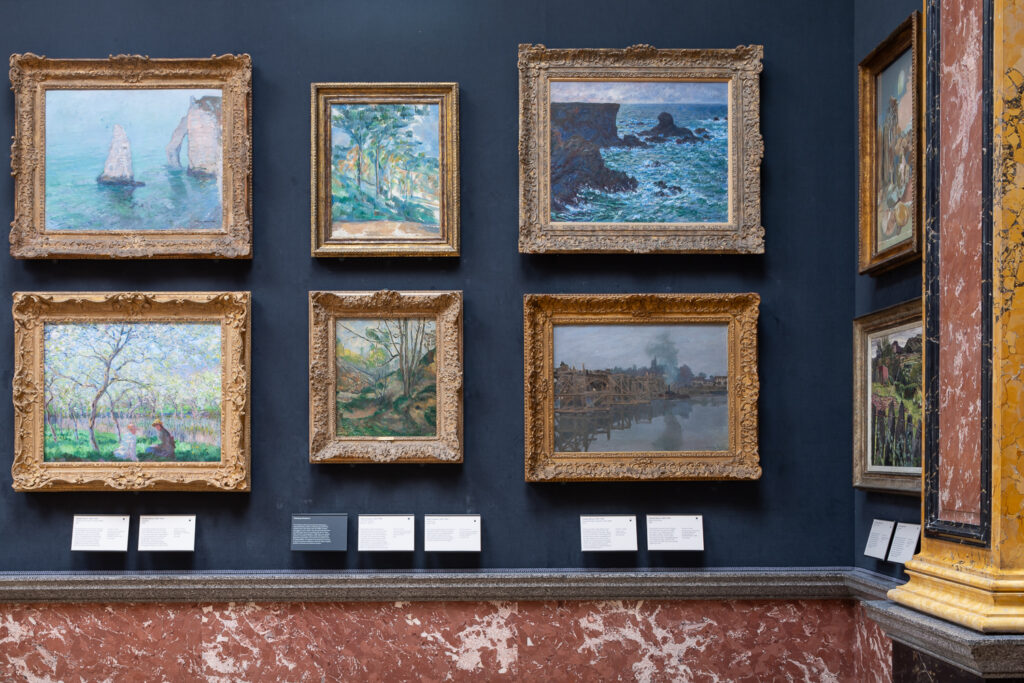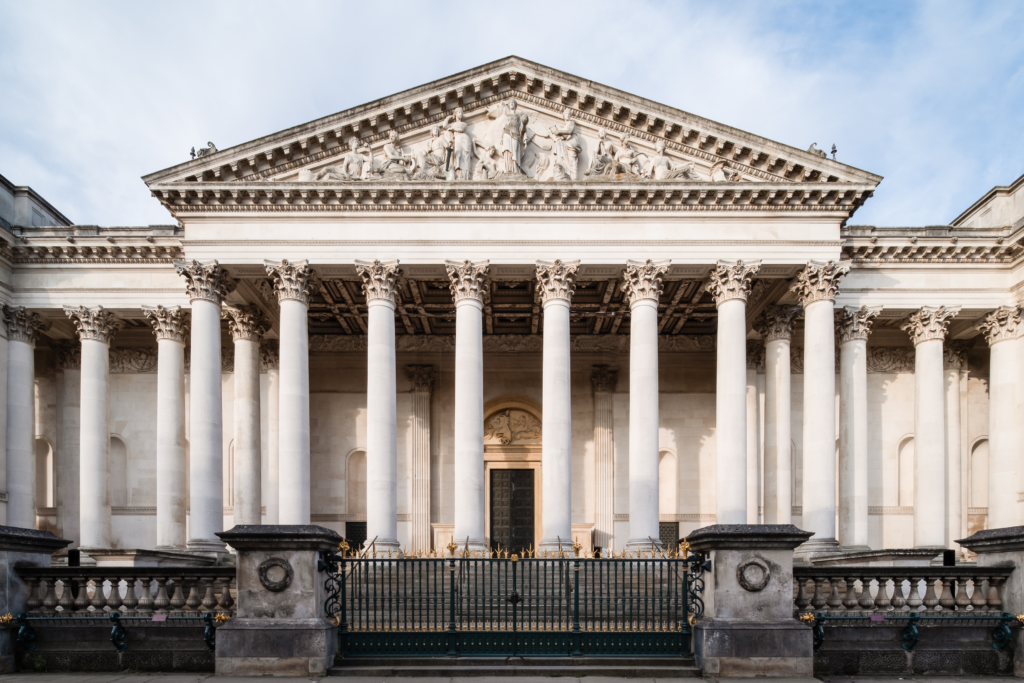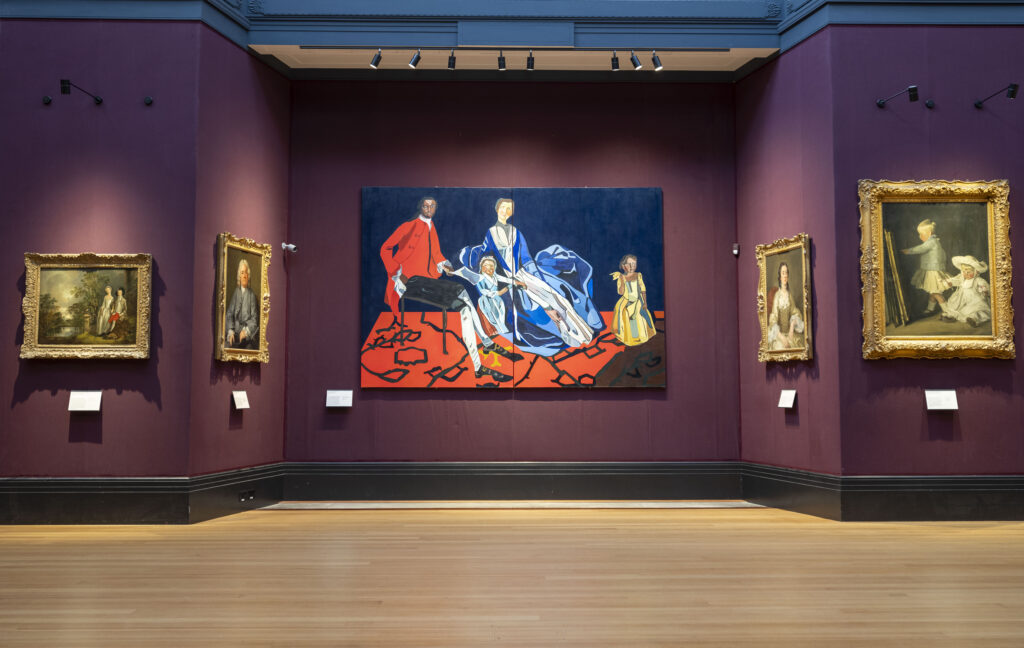Enjoy this article?
Most Museums Journal content is only available to members. Join the MA to get full access to the latest thinking and trends from across the sector, case studies and best practice advice.
The Fitzwilliam Museum in Cambridge reopened its main painting galleries in March after a four-year revamp. The five redisplayed spaces all have a different theme and reflect the organisation’s ongoing diversification of its collection. Popular works are shown alongside new acquisitions as well as those pulled from the store that haven’t been displayed before.
Visitors enter the museum via the main staircase, with revolving doors leading them to front-of-house staff and a stand displaying floorplans that identify the painting galleries by their new themes. The five galleries are on the top floor. A longer, less direct, step-free route is accessed by the courtyard entrance.
There are four entrances to the galleries. Visitors can follow the floorplan and walk round chronologically or via two other doors leading off the stairs or through the Italian art gallery.
This isn’t a problem as the galleries are a series of mini displays and the hang is so well done that whichever entrance you take you are greeted with inviting works.
The galleries are very open. There is less furniture from the decorative art collection on display than before and no barriers, so visitors can admire the works as closely as they like, though there is an attendant in each gallery to stop any contact. The beautifully lit galleries have dark-silk walls, with spotlights giving a jewellery box feel to each painting.
With the bright, high ceilings and roof windows the spaces also feel calm and navigable. The only issue is that higher hung paintings are sometimes hard to see due to unavoidable reflections, but space in the gallery means you are able to move around to find the right spot to view them clearly.

The labels are accessible and pre-empted my questions. The tone is excellent – some draw you further into the paintings, such as the label on the 19th-century artist Édouard Vuillard that points you to the little dog in the corner, while others put the paintings into the context of the wider world and Britain’s difficult history. The structure of the labels also allows many to have thought-provoking final sentences that are quietly damning for some and poignant for others.
The new themes of the galleries are: Interiors; Men Looking at Women; Migrations and Movement; Nature; and Identity, which is the largest. Each of these main themes is explained on a text panel as you enter and then works are displayed in smaller sub-themes like mini exhibitions. These themes allow the museum to show a true mix of its holdings.
In Gallery 1, Interiors, there are subtle hints of traditional chronological art history. For instance, the works of painters Walter Sickert and Spencer Gore can be seen through a case containing wax statuettes of dancers by the impressionist Edgar Degas, but there are also striking new additions such as the Scottish painter Ethel Walker’s work Silence of the Ravine, which depicts a female nude.
There is thoughtfulness in the hang – Walker’s large nude is given space so visitors can stand back and take in this provocative work, while the Sickert and Gore paintings are more crowded, just like the cramped grubby rooms that they depict.

The smaller sections within the themes allow for charming groupings such as Women Reading, where formal 18th-century portraits are hung alongside 20th-century images of women comfortably engrossed in their books.
The text tells us of the changes in female literacy in Europe, from 30% when the first painting was made to 95% when Gwen John painted The Convalescent in 1918-19.
Works on the dark-green silk walls of Gallery 2, entitled Men Looking at Women, show the shift in the depiction of women as attitudes changed over the centuries.
The gallery’s interpretation guides visitors through the reality of what they are seeing, from Stanley Spencer’s anxiety-laden 1937 work Self Portrait with Patricia Preece to John Everett Millais’s 1876 double portrait of The Twins, Kate and Grace Hoare, which “capture[s] their different personalities”. The Twins are hung so they are framed by the doorway of Gallery 3.
There is also humour within the hang. In a section on Virtue, the 17th-century Dutch painter Peter Lely’s authoritative portrait of Mary Parsons looks down upon English pictorial satirist William Hogarth’s mockery of a sexual encounter in the two paintings Before and After.
The third gallery, Identity, is where the Fitzwilliam’s aim in telling a more expansive and inclusive story of art is stunningly fulfilled. Where once portraits of white aristocrats hung, there is now contemporary artist Joy Labinjo’s imagined family portrait of abolitionist Olaudah Equiano with his wife Susanna Cullen and two children.
The clever positioning of Labinjo’s work, which the Fitzwilliam bought in 2022, means that it can be seen through the gallery’s three entrances and the effect of this striking work against the dark walls is glorious.
Identity focuses on portraits and their functions as political tools and shows of wealth. It also highlights portraits of “people previously excluded from, or left on the margins of art”.
If you enter from the stairway, the gallery’s intentions are clearly set out. On your right is a portrait of Richard Fitzwilliam, whose bequest of £100,000, as the label explains, founded the museum but was earned in part through the transatlantic slave trade.

Opposite him is the more recognisable figure of American writer and thinker Henry Louis Gates Jr who studied at Cambridge University in the 1970s. The work by Kerry James Marshall, acquired by the museum in 2023, was painted to highlight the absence of Black figures in museums.
Some other changes are more subtle. The 17th-century portraits of Sir John Finch and Sir Thomas Baines by Carlo Dolci, which were previously hung opposite each other, are now hung in corresponding corners. The “lifelong companions” can now gaze upon each other more closely and visitors, as the third in their triangle, can be part of the conversation.
In Gallery 4, Migration and Movement, smaller sub-themes focus on Roma and Travelling Communities as well as Jewish Artists and the Legacy of Exile.
Here are well-known works such as The Last of England by Ford Madox Brown along with a good representation of works by Marie-Louise von Motesiczky who fled Nazi-occupied Austria in the 1930s.
Works by other Jewish emigré artists Mark Gertler, Frank Auerbach and David Bomberg hang near to two beautiful works by Guyana-born 20th-century artist Aubrey Williams.
The final gallery, Nature, could have been an excuse to show the Fitzwilliam’s French impressionist collection, but while there are important works by Claude Monet and Paul Cézanne the curators have focused on landscape painting’s entanglement with national and cultural identity.
There are paintings by British artists Paul Nash and Stanley Spencer, whose sense of place was hugely important to their work, and a fascinating section on Women and Landscape that has a beautiful work by little-known British artist Kaff Gerrard.
The Fitzwilliam’s rehang reveals new artists and viewpoints as well as re-presenting much-loved works, but most importantly it describes the reality of our history.
Exemplified by the bust of Queen Victoria in Gallery 3 that depicts her not as an idealised monarch but as an ageing woman, these new displays allow us to see more clearly the lives of others, and in doing so spark new and important conversations.
Victoria Partridge is the keeper of fine and decorative art at The Higgins art gallery and museum, Bedford
Most Museums Journal content is only available to members. Join the MA to get full access to the latest thinking and trends from across the sector, case studies and best practice advice.